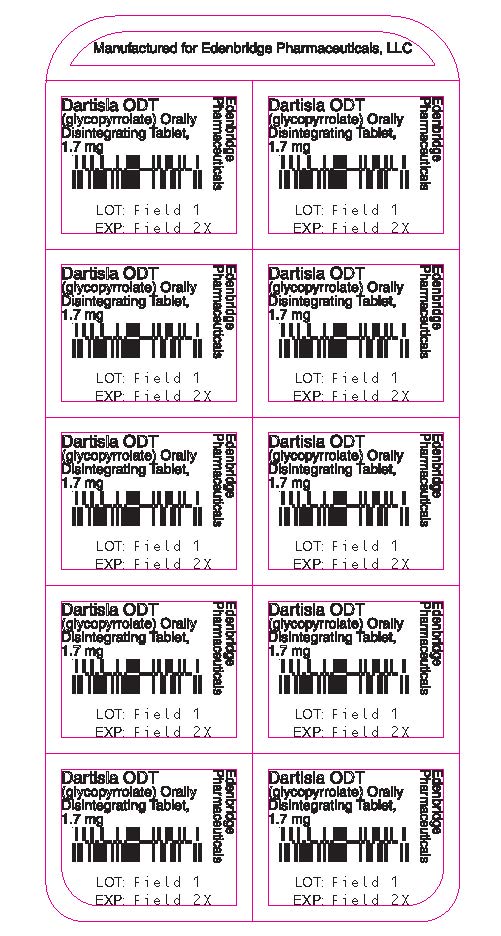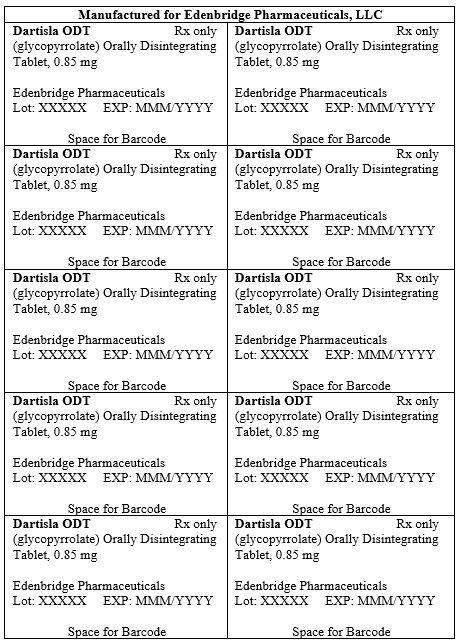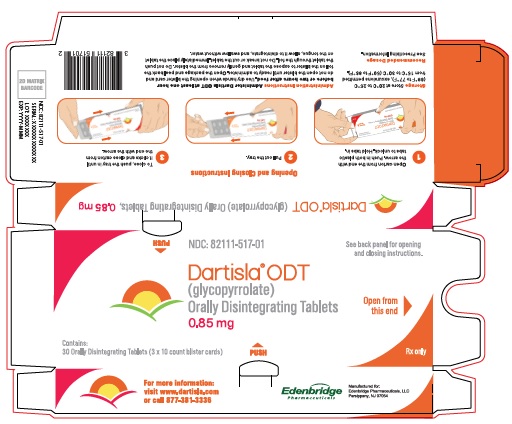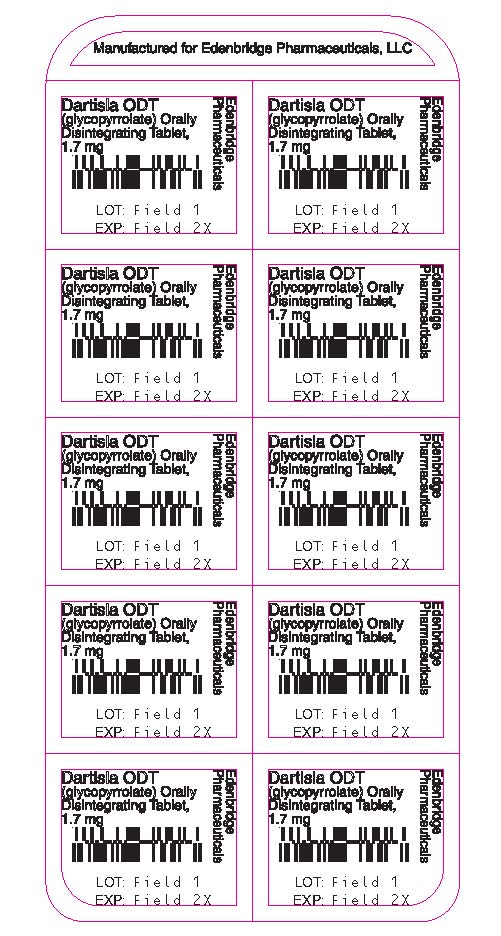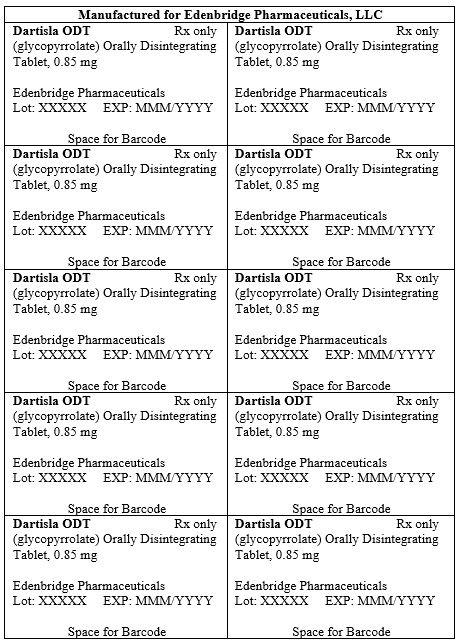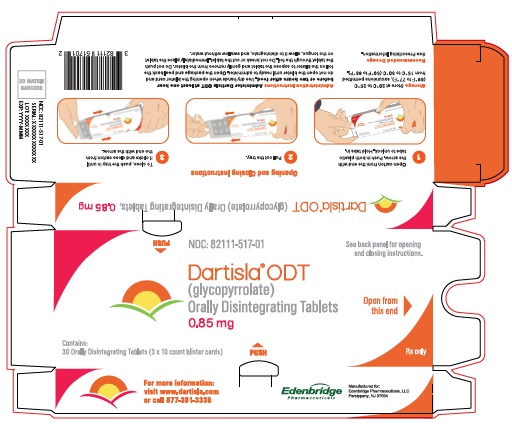Label: DARTISLA ODT- glycopyrrolate orally disintegrating tablets tablet, orally disintegrating
- NDC Code(s): 82111-517-01, 82111-518-01
- Packager: Edenbridge Pharmaceuticals LLC.
- Category: HUMAN PRESCRIPTION DRUG LABEL
- DEA Schedule: None
- Marketing Status: New Drug Application
Drug Label Information
Updated October 19, 2023
If you are a consumer or patient please visit this version.
- Download DRUG LABEL INFO: PDF XML
- Official Label (Printer Friendly)
-
HIGHLIGHTS OF PRESCRIBING INFORMATION
These highlights do not include all the information needed to use DARTISLA ODT safely and effectively. See full prescribing information for DARTISLA ODT.
DARTISLA ODT (glycopyrrolate) Orally Disintegrating Tablets
Initial U.S. Approval: 1961
RECENT MAJOR CHANGES
Dosage and Administration
Important Dosing information 09/2023
Recommended Dosage 09/2023INDICATIONS AND USAGE
DOSAGE AND ADMINISTRATION
Important Dosing Information (2.1)
Patients receiving another oral tablet dosage form of glycopyrrolate may be switched as follows:.
- 1 mg dosage strength to DARTISLA ODT 0.85 mg.
- 2 mg dosage strength to DARTISLA ODT 1.7 mg
Recommended Dosage
- Initial Dosage: 0.85 mg three times daily (in the morning, early afternoon, and at bedtime) at leasy one hour before or two hours after food. (2.2,2.3)
- May require 1.7 mg at bedtime for overnight control of symptoms. (2.2)
- For maintenance, 0.85 mg twice a day is frequently adequate. (2.2)
- Dosage for patients switching from 2 mg glycopyrrolate products: 1.7 mg two or three times daily at equally spaced intervals. (2.2)
- Maximum recommended daily dosage is 6.8 mg. (2.2)
- Use the lowest effective dosage to control symptoms. (2.2)
DOSAGE FORMS AND STRENGTHS
- Orally Disintegrating Tablets: 0.85 mg and 1.7 mg (3)
CONTRAINDICATIONS
WARNINGS AND PRECAUTIONS
- Precipitation of Acute Glaucoma: May increase intraocular pressure; if symptoms occur, discontinue use, and promptly seek medical care. (4, 5.1)
- Partial or Complete Mechanical Intestinal Obstruction: Diarrhea may be an early symptom especially if ileostomy or colostomy. If obstruction is suspected, discontinue use and evaluate for obstruction. (4, 5.2)
- GI Adverse Reactions Due to Decreased GI Motility: Delayed gastric emptying, constipation and intestinal pseudo-obstruction may occur and result in paralytic ileus and toxic megacolon; not recommended with anticholinergics or other drugs that decrease GI peristalsis. (4, 5.3, 7.1)
- Cognitive and Visual Adverse Reactions: May impair mental and/or physical function. Inform patients not to operate motor vehicles or perform other hazardous tasks until reasonably certain they are not adversely affected; discontinue use if signs or symptoms develop. (5.4, 7.1)
- Heat Prostration at High Environmental Temperatures: Heat prostration resulting in fever and heat stroke can occur, especially in geriatric patients. Avoid exposure to hot or very warm environmental temperatures. (5.5, 5.7)
- Other Conditions Exacerbated by Anticholinergic Adverse Reactions: Use is not recommended in patients with autonomic neuropathy, hyperthyroidism, cardiac disease, hiatal hernia, etc. (5.6, 7.1)
- Increased Risk in Anticholinergic Adverse Reactions in Geriatric Patients: Due to complications not recommended in geriatric patients: and may be contraindicated with some underlying medical conditions (4, 5.7, 8.5)
ADVERSE REACTIONS
Adverse reactions include blurred vision, drowsiness, decreased sweating, flushing, vomiting, constipation, dry mouth, tachycardia, and urinary retention. (6)
To report SUSPECTED ADVERSE REACTIONS, contact Edenbridge Pharmaceuticals, LLC at 1-877-381-3336 or FDA at 1-800-FDA-1088 or www.fda.gov/medwatch. (6)
DRUG INTERACTIONS
USE IN SPECIFIC POPULATIONS
- Renal Impairment: Discontinue if anticholinergic adverse reactions. (8.6)
See 17 for PATIENT COUNSELING INFORMATION.
Revised: 10/2023
-
Table of Contents
FULL PRESCRIBING INFORMATION: CONTENTS*
1 INDICATIONS & USAGE
2 DOSAGE & ADMINISTRATION
2.1 Important Dosing Information
2.2 Recommended Dosage
2.3 Administration Instructions
3 DOSAGE FORMS & STRENGTHS
4 CONTRAINDICATIONS
5 WARNINGS AND PRECAUTIONS
5.1 Precipitation of Acute Glaucoma
5.2 Partial or Complete Mechanical Intestinal Obstruction
5.3 Gastrointestinal Adverse Reactions Due to Decreased Gastrointestinal Motility
5.4 Cognitive and Visual Adverse Reactions
5.5 Heat Prostration at High Environmental Temperatures
5.6 Other Conditions Exacerbated by Anticholinergic Adverse Reactions
5.7 Increased Risk of Anticholinergic Adverse Reactions in Geriatric Patients
6 ADVERSE REACTIONS
7 DRUG INTERACTIONS
7.1 Other Anticholinergic Drugs
7.2 Drugs with Altered Absorption due to Decreased Gastrointestinal Motility and Increased Transit Time
7.3 Gastrointestinal Toxicity with Solid Oral Dosage Forms of Potassium Chloride
8 USE IN SPECIFIC POPULATIONS
8.1 Pregnancy
8.2 Lactation
8.4 Pediatric Use
8.5 Geriatric Use
8.6 Renal Impairment
10 OVERDOSAGE
11 DESCRIPTION
12 CLINICAL PHARMACOLOGY
12.1 Mechanism of Action
12.2 Pharmacodynamics
12.3 Pharmacokinetics
13 NONCLINICAL TOXICOLOGY
13.1 Carcinogenesis & Mutagenesis & Impairment Of Fertility
16 HOW SUPPLIED/STORAGE AND HANDLING
17 PATIENT COUNSELING INFORMATION
- *
- Sections or subsections omitted from the full prescribing information are not listed.
- 1 INDICATIONS & USAGE
-
2 DOSAGE & ADMINISTRATION
2.1 Important Dosing Information
- Patients receiving the 1 mg dosage strength of another oral tablet dosage form of glycopyrrolate may be switched to the 0.85 mg dosage strength of DARTISLA ODT [see Dosage Forms and Strengths (3) and Clinical Pharmacology (12.3)].
- Patients receiving the 2 mg dosage strength of another oral tablet dosage form of glycopyrrolate may be switched to the 1.7 mg dosage strength of DARTISLA ODT [see Dosage Forms and Strengths (3) and Clinical Pharmacology (12.3)].
2.2 Recommended Dosage
Initial dosage:
• The recommended initial dosage is 0.85 mg orally three times daily (in the morning, early afternoon, and at bedtime).
• Some patients may require 1.7 mg at bedtime to assure overnight control of symptoms.
• For maintenance, a dosage of 0.85 mg orally twice is frequently adequate.Dosage for patients switching from 2 mg glycopyrrolate products:
• The recommended dosage is 1.7 mg two or three times daily at equally spaced intervals.
• The maximum recommended daily dosage is 6.8 mg.
• Use the lowest effective dosage to control symptoms.2.3 Administration Instructions
- Administer DARTISLA ODT at least one hour before or two hours after food [see Clinical Pharmacology (12.3)].
- Use dry hands when opening the blister card and do not open the blister until ready to administer.
- Open the package and peel back the foil on the blister to expose the tablet and gently remove from the blister. Do not push the tablet through the foil.
- Do not break or cut the tablet.
- Immediately place the tablet on the tongue, allow it to disintegrate, and swallow without water.
- 3 DOSAGE FORMS & STRENGTHS
-
4 CONTRAINDICATIONS
DARTISLA ODT is contraindicated in:
- Patients at risk for anticholinergic toxicity due to an underlying medical condition, including:
- Glaucoma [see Warnings and Precautions (5.1)]
- Obstructive uropathies including prostatic hypertrophy
- Mechanical obstructive diseases of gastrointestinal tract (e.g., pyloroduodenal stenosis, strictures) [see Warnings and Precautions (5.2)]
- Gastrointestinal motility disorders (e.g., achalasia, paralytic ileus, intestinal atony) [see Warnings and Precautions (5.3)]
- Bleeding gastrointestinal ulcer
- Active inflammatory or infectious colitis which can lead to toxic megacolon
- History of or current toxic megacolon
- Myasthenia gravis
- Patients with a hypersensitivity to glycopyrrolate or any of the inactive ingredients in DARTISLA ODT [see Adverse Reactions (6) and Description (11)].
- Patients at risk for anticholinergic toxicity due to an underlying medical condition, including:
-
5 WARNINGS AND PRECAUTIONS
5.1 Precipitation of Acute Glaucoma
Glycopyrrolate may cause increased intraocular pressure in patients with glaucoma and reduce the effects of antiglaucoma agents. Instruct patients to discontinue DARTISLA ODT and promptly seek medical care if they experience symptoms of acute angle closure glaucoma (pain and reddening of the eyes accompanied by dilated pupils) [see Contraindications (4)]
5.2 Partial or Complete Mechanical Intestinal Obstruction
DARTISLA ODT may worsen intestinal mechanical obstruction, and diarrhea may be an early symptom of incomplete intestinal obstruction, especially in patients with ileostomy or colostomy. If partial or complete intestinal obstruction is suspected, discontinue use of DARTISLA ODT and evaluate for potential intestinal obstruction [see Contraindications (4)].
5.3 Gastrointestinal Adverse Reactions Due to Decreased Gastrointestinal Motility
Glycopyrrolate reduces gastrointestinal motility and may result in delayed gastric emptying, constipation, and intestinal pseudo-obstruction and may precipitate or aggravate paralytic ileus and toxic megacolon [see Contraindications (4)]. The risk of gastrointestinal adverse reactions is further increased with use of other anticholinergics and other medications that decrease gastrointestinal peristalsis. Monitor patients for symptoms of decreased gastrointestinal motility. Concomitant use of DARTISLA ODT and other anticholinergics or other medications that decrease GI peristalsis is not recommended [see Drug Interactions (7.2)].
5.4 Cognitive and Visual Adverse Reactions
Glycopyrrolate may produce drowsiness and blurred vision and impair the mental and/or physical abilities required for the performance of hazardous tasks such as driving a motor vehicle, operating machinery or performing other hazardous work [see Adverse Reactions (6)]. Concomitant use of other drugs that have anticholinergic properties may increase these effects [see Drug Interactions (7.1)]. Inform patients not to operate motor vehicles or other dangerous machinery or perform other hazardous tasks until they are reasonably certain that DARTISLA ODT does not affect them adversely. Discontinue DARTISLA ODT if signs or symptoms of cognitive or visual impairment develop.
5.5 Heat Prostration at High Environmental Temperatures
In the presence of a high environmental temperature, heat prostration resulting in fever and heat stroke can occur with use of DARTISLA ODT due to decreased sweating, particularly in geriatric patients [see Adverse Reactions (6)]. Advise patients to avoid exposure to hot or very warm environmental temperatures when taking DARTISLA ODT. DARTISLA ODT is not recommended in geriatric patients [see Warnings and Precautions (5.7)].
5.6 Other Conditions Exacerbated by Anticholinergic Adverse Reactions
DARTISLA ODT is not recommended in patients with other conditions exacerbated by anticholinergic adverse reactions (e.g., autonomic neuropathy, hyperthyroidism, cardiac disease, and hiatal hernia associated with reflux esophagitis) and in patients taking other anticholinergic medications [see Drug Interactions (7.1)].
5.7 Increased Risk of Anticholinergic Adverse Reactions in Geriatric Patients
Geriatric patients 65 years of age and older are at increased risk of anticholinergic adverse reactions that may lead to complications of urinary retention, bowel obstruction, heat prostration, arrhythmias, delirium, and falls or fractures. DARTISLA ODT is not recommended in geriatric patients and may be contraindicated in some geriatric patients with underlying medical conditions [see Contraindications (4), Warnings and Precautions (5.2, 5.5), Adverse Reactions (6) and Use in Specific Populations (8.5)].
-
6 ADVERSE REACTIONS
The following serious or otherwise important adverse reactions are discussed elsewhere in the labeling:
- Precipitation of Acute Glaucoma [see Warnings and Precautions (5.1)]
- Partial or Complete Mechanical Intestinal Obstruction [see Warnings and Precautions (5.2)]
- Gastrointestinal Adverse Reactions due to Decreased Gastrointestinal Motility [see Warnings and Precautions (5.3)]
- Cognitive and Visual Adverse Reactions [see Warnings and Precautions (5.4)]
- Heat Prostration at High Environmental Temperatures [see Warnings and Precautions (5.5)]
- Other Conditions Exacerbated by Anticholinergic Adverse Reactions [see Warnings and Precautions (5.6)]
- Increased Risk of Anticholinergic Adverse Reactions in Geriatric Patients [see Warnings and Precautions (5.7)]
The following adverse reactions associated with the use of glycopyrrolate, or other anticholinergic drugs, were identified in clinical studies or postmarketing reports. Because some of these reactions are reported voluntarily from a population of uncertain size, it is not always possible to reliably estimate their frequency or establish a causal relationship to drug exposure.
Cardiac Disorders: chest, pain, hypertension, tachycardia
Endocrine Disorders: decreased sweating
Eye Disorders: blurred vision, cycloplegia, dilatation of the pupil, increased ocular tension
Gastrointestinal Disorders: bloated feeling, constipation, dry mouth, dysgeusia, nausea, vomiting
Immune System Disorders: anaphylaxis [see Contraindications (4)]
Nervous System Disorders: agitation, dizziness, drowsiness, headache, insomnia, mental confusion, nervousness, weakness
Respiratory Disorders: respiratory depression, throat irritation
Renal and Urinary Disorders: urinary hesitancy, urinary retention
Reproductive System and Breast Disorders: impotence, suppression of lactation
Vascular Disorders: flushing
-
7 DRUG INTERACTIONS
7.1 Other Anticholinergic Drugs
There is potential for an additive interaction between glycopyrrolate and concomitantly used anticholinergic drugs (e.g., tricyclic antidepressants, anti-epileptics, class I antiarrhythmics, anti-spasmodics, amantadine) resulting in increased anticholinergic adverse reactions. Coadministration of antipsychotics with glycopyrrolate may lead to worsening of tardive dyskinesia. DARTISLA ODT is not recommended in patients taking other anticholinergic drugs [see Warnings and Precautions (5.3, 5.4, 5.6)].
7.2 Drugs with Altered Absorption due to Decreased Gastrointestinal Motility and Increased Transit Time
Decreased gastrointestinal motility by glycopyrrolate may impact absorption of other drugs leading to increased or decreased drug exposure. DARTISLA ODT is not recommended in patients taking other drugs that are affected by altered gastrointestinal motility. [see Warnings and Precautions (5.3)].
7.3 Gastrointestinal Toxicity with Solid Oral Dosage Forms of Potassium Chloride
Oral glycopyrrolate may worsen gastrointestinal mucosal injury reported with solid oral dosage forms of potassium chloride due to decreased gastric motility and increased transit time leading to prolonged contact with the gastrointestinal mucosa. DARTISLA ODT is not recommended in patients taking solid oral dosage forms of potassium chloride.
-
8 USE IN SPECIFIC POPULATIONS
8.1 Pregnancy
Risk Summary
Over decades of use, there is an absence of published data on orally administered glycopyrrolate in pregnant women, including an absence of any reports of a drug-associated risk of major birth defects, miscarriage, or other adverse maternal or fetal outcomes. In animal studies, at non-maternally toxic doses of oral glycopyrrolate, there were no adverse developmental effects in rats or rabbits. A pre- and post-natal development study of oral glycopyrrolate in rats showed a decrease in pup mean body weight that recovered post nursing, with no other developmental effects observed (see Data).
The estimated background risk of major birth defects and miscarriage for the indicated population is unknown. All pregnancies have a background risk of birth defect, loss, or other adverse outcomes. In the U.S. general population, the estimated background risk of major birth defects and miscarriage in clinically recognized pregnancies is 2% to 4% and 15% to 20%, respectively.
Data
Animal Data
At non-maternally toxic doses of oral glycopyrrolate there were no effects on embryo-fetal development or toxicity in rats or rabbits. A pre- and post-natal development study of oral glycopyrrolate in rats showed a decrease in pup mean body weight that recovered post nursing, with no other developmental effects observed.
In a published reproductive and developmental study, male and female rats were administered glycopyrrolate in the diet at 0, 32.5, 63 and 130 mg/kg/day for 3 to 5 weeks and through up to three consecutive litters. There was no indication of abnormalities in the pups of treated dams. There was a decreased rate of conception and in survival rate at weaning for all treated animals in a dose-related manner. Diminished rates of conception may be due to diminished seminal secretion [see Nonclinical Toxicology (13.1)].
8.2 Lactation
Risk Summary
There are no data on the presence of glycopyrrolate in either human or animal milk, the effects on the breastfed infant, or the effects on milk production. As with other anticholinergic drugs, glycopyrrolate may cause suppression of lactation. The developmental and health benefits of breastfeeding should be considered along with the mother's clinical need for DARTISLA ODT and any potential adverse effects on the breastfed infant from DARTISLA ODT.
8.5 Geriatric Use
Geriatric patients 65 years of age and older may be more sensitive to the anticholinergic adverse reactions of glycopyrrolate leading to complications of urinary retention, bowel obstruction, heat prostration, arrhythmias, delirium, and falls or fractures;therefore, DARTISLA ODT is not recommended in geriatric patients and may be contraindicated in some geriatric patients with underlying medical conditions [see Contraindications (4) and Warnings and Precautions (5)].
- 9 DRUG ABUSE AND DEPENDENCE
-
10 OVERDOSAGE
Signs and symptoms of glycopyrrolate overdosage are related to excessive anti-muscarinic anticholinergic activity and are generally peripheral (e.g., flushing, hyperthermia, tachycardia, ileus, urinary retention, loss of ocular accommodation and light sensitivity due to mydriasis), but central nervous system toxicity (agitation, seizures, hyperthermia) may also occur.
If over-exposure occurs, call the Poison Control Center at 1-800-222-1222 for current information on the management of glycopyrrolate poisoning and overdosage.
Management of glycopyrrolate overdosage is based upon presenting signs and symptoms, including close observation for severe or life-threatening complications which may require respiratory and cardiovascular monitoring and support. Consider administration of activated charcoal and/or use of a reversible anticholinesterase as appropriate or recommended by Poison Control.
-
11 DESCRIPTION
DARTISLA ODT (glycopyrrolate) orally disintegrating tablets contains the synthetic anticholinergic, glycopyrrolate. Glycopyrrolate is a quaternary ammonium compound with the following chemical name: 3-[(cyclopentylhydroxyphenylacetyl)oxy]-1,1-dimethylpyrrolidinium bromide. The empirical formula for glycopyrrolate is C19H28BrNO3, the molecular weight is 398.3 g/mol, and the structural formula is:
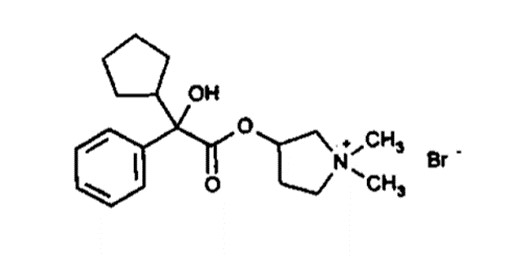
Each DARTISLA ODT contains: glycopyrrolate, USP 0.85 mg or 1.7 mg as the active ingredient. The inactive ingredients include black cherry, citric acid, fish gelatin (high molecular weight), mannitol, poloxamer 188, purified water and sucralose micronized.
-
12 CLINICAL PHARMACOLOGY
12.1 Mechanism of Action
Glycopyrrolate, an anticholinergic (antimuscarinic) agent, inhibits the action of acetylcholine on parietal cells in the stomach and decreases the volume and acidity of gastric secretions.
12.3 Pharmacokinetics
Absorption
After DARTISLA ODT administration under fasted conditions, the mean (SD) Cmax was 390 (±237) pg/mL, and the mean AUC0-t and AUC0-inf was 1862 (±1116) and 1977 (± 1171) pg·hr/mL, respectively. The median time to maximum plasma concentration was 3 hours. After DARTISLA ODT 1.7 mg administration, the Cmax and AUC of glycopyrrolate were comparable to an oral 2 mg glycopyrrolate tablet [see Dosage and Administration (2.2)].
When DARTISLA ODT was placed in the mouth and immediately swallowed with 240 mL water, the mean Cmax and AUC of glycopyrrolate decreased by 24% and 20%, respectively, compared to administration without water [see Dosage and Administration (2.2)].
Effect of Food
In healthy adults, a high-fat, high-calorie meal (939 calories, 60% fat) significantly reduced the absorption of glycopyrrolate following administration of DARTISLA ODT 1.7 mg. The mean Cmax and AUC were approximately 83% and 77% lower, respectively, than those observed under fasted conditions [see Dosage and Administration (2.2)].
Elimination
After DARTISLA ODT 1.7 mg administration, the mean plasma half-life was 2.8 hours.
Specific Populations
Patients with Renal Impairment
In published literature, glycopyrrolate 4 mcg/kg was administered intravenously (DARTISLA ODT is not recommended for intravenous use) in uremic patients undergoing renal transplantation surgery. The mean AUC (10.6 mcg·h/L), and 24-hour urinary excretion (7%) for glycopyrrolate were significantly different from normal healthy adult subjects undergoing general surgery (3.7 mcg·h/L, and 65%, respectively) [see Use in Specific Populations (8.6)]. -
13 NONCLINICAL TOXICOLOGY
13.1 Carcinogenesis & Mutagenesis & Impairment Of Fertility
Reproduction studies in rats resulted in diminished rates of conception, in a dose-related manner. Studies in dogs suggest that diminished rates of conception may be due to diminished seminal secretion, which is evident at high doses of glycopyrrolate.
-
16 HOW SUPPLIED/STORAGE AND HANDLING
DARTISLA ODT is supplied as:
0.85 mg glycopyrrolate as a white to off-white, round orally disintegrating tablet debossed with the symbol
 . Available as:
. Available as:- NDC 82111-517-01: 30 orally disintegrating tablets per carton. Each carton has 3 blister cards containing 10 orally disintegrating tablets each.
1.7 mg glycopyrrolate as a white to off-white, round orally disintegrating tablets debossed with the symbol
 . Available as:
. Available as:- NDC 82111-518-01: 30 orally disintegrating tablets per carton. Each carton has 3 blister cards containing 10 orally disintegrating tablets each.
Store at 20°C to 25°C (68°F to 77°F); with excursions between 15°C to 30°C (59°F to 86°F) [USP controlled room temperature].
-
17 PATIENT COUNSELING INFORMATION
Precipitation of Acute Glaucoma
Advise patient to discontinue DARTISLA ODT and promptly seek medical care if they experience symptoms of acute angle closure glaucoma (pain and reddening of the eyes accompanied by dilated pupils) [see Warnings and Precautions (5.1)].
Partial or Complete Mechanical Intestinal Obstruction
Advise patients to contact their healthcare provider if diarrhea occurs, especially in patients with ileostomy or colostomy [see Warnings and Precautions (5.2)].
Gastrointestinal Adverse Reactions Due to Decreased Gastrointestinal Motility
Inform patients that DARTISLA ODT may cause adverse reactions related to decreased gastrointestinal motility and to report to their healthcare provider if they experience symptoms such as vomiting, early satiety, abdominal distention, and constipation [see Warnings and Precautions (5.3)].
Cognitive and Visual Adverse Reactions
Inform patients that DARTISLA ODT may cause cognitive or visual impairment and not to operate motor vehicles or other dangerous machinery or perform other hazardous tasks until they are reasonably certain that DARTISLA ODT does not affect them adversely. Advise patients to discontinue DARTISLA ODT immediately and contact their healthcare provider if symptoms develop (e.g., drowsiness or blurred vision) [see Warnings and Precautions (5.4)].
Heat Prostration at High Environmental Temperatures
Inform patients that DARTISLA ODT can reduce sweating, leading to the possibility of heat exhaustion or heat stroke. Advise patients to avoid exposure to hot or very warm environmental temperatures [see Warnings and Precautions (5.5)].
Dosage and Administration Instructions
- Administer DARTISLA ODT at least one hour before or two hours after food [see Dosage and Administration (2.2)].
- Use dry hands when handling the blister card and do not open the blister until ready to administer.
- Open the package and peel back the foil on the blister to expose the tablet and gently remove from the blister. Do not push the tablet through the foil.
- Do not break or cut the tablet.
- Immediately place the tablet on the tongue, allow it to disintegrate, and swallow without water [see Dosage and Administration (2.3)].
Manufactured by:
Catalent Pharma Solutions Limited
Frankland Road
Blagrove, Swindon
Wiltshire SN5 8RU, United Kingdom (GBR)
Manufactured for:
Edenbridge Pharmaceuticals, LLC
Parsippany, NJ 07054

© 2023 Edenbridge Pharmaceuticals, LLC
- PACKAGE LABEL.PRINCIPAL DISPLAY PANEL
-
INGREDIENTS AND APPEARANCE
DARTISLA ODT
glycopyrrolate orally disintegrating tablets tablet, orally disintegratingProduct Information Product Type HUMAN PRESCRIPTION DRUG Item Code (Source) NDC:82111-518 Route of Administration ORAL Active Ingredient/Active Moiety Ingredient Name Basis of Strength Strength GLYCOPYRROLATE (UNII: V92SO9WP2I) (Glycopyrronium - UNII:A14FB57V1D) GLYCOPYRROLATE 1.7 mg Product Characteristics Color WHITE Score no score Shape ROUND Size 2mm Flavor CHERRY Imprint Code Double;bridge Contains Packaging # Item Code Package Description Marketing Start Date Marketing End Date 1 NDC:82111-518-01 3 in 1 CARTON 02/01/2022 1 10 in 1 BLISTER PACK; Type 0: Not a Combination Product Marketing Information Marketing Category Application Number or Monograph Citation Marketing Start Date Marketing End Date NDA NDA215019 02/01/2022 10/11/2023 DARTISLA ODT
glycopyrrolate orally disintegrating tablets tablet, orally disintegratingProduct Information Product Type HUMAN PRESCRIPTION DRUG Item Code (Source) NDC:82111-517 Route of Administration ORAL Active Ingredient/Active Moiety Ingredient Name Basis of Strength Strength GLYCOPYRROLATE (UNII: V92SO9WP2I) (Glycopyrronium - UNII:A14FB57V1D) GLYCOPYRROLATE 0.85 mg Product Characteristics Color WHITE Score no score Shape ROUND Size 2mm Flavor CHERRY Imprint Code Single;bridge Contains Packaging # Item Code Package Description Marketing Start Date Marketing End Date 1 NDC:82111-517-01 3 in 1 CARTON 10/11/2023 1 10 in 1 BLISTER PACK; Type 0: Not a Combination Product Marketing Information Marketing Category Application Number or Monograph Citation Marketing Start Date Marketing End Date NDA NDA215019 10/11/2023 Labeler - Edenbridge Pharmaceuticals LLC. (948715060)

